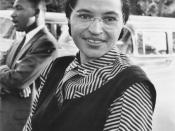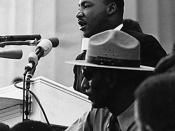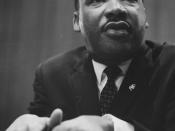"Peace for All"
Mahatma Gandhi first started his movement of non-violence in India during the late 1800's - early 1900's. He became active in the struggle to end the humiliations and indignities that people were facing in South Africa when he traveled to there to represent an Indian trader in Natal in a civil suit against an Indian trading firm. Within days of being in South Africa he was pushed out of a train and assaulted for walking on a footpath. It was those experiences that made him decide to never accept or to be resigned to injustice and racism, but to resist.
Dr. Martin Luther King Jr. was a principal leader in the American civil rights movement in the 1950's and 1960's. He was a prominent advocate for non-violent protest and admired Mahatma Gandhi and his principles of non-violent persuasion. Dr. King visited India in 1959, to learn a better understanding of Gandhi's teachings of peace and non-violence.
Dr. Martin Luther King Jr.'s speech "I Have a Dream" and an essay written by Ela Gandhi titled "Gandhi's Vision of Peace" have the same message of non-violence. Ela Gandhi is Mahatma Gandhi's granddaughter and utilizes her grandfather's principles and beliefs in a speech given at the ninth Desmond Tutu Peace Lecture during 1993, after Apartheid had ended.
Peace and equality are themes that I admire in the writings and teachings of Mahatma Gandhi and Dr. Martin Luther King Jr. Both leaders strived to teach the lessons of freedom and enlightenment without violence on two different continents.
The peaceful demonstration where Dr. King gave his speech "I Have a Dream" and the struggle for liberation in South Africa were similar campaigns. In both places, thousands took to the streets in demonstration to draw attention to their cause. While American authorities...


